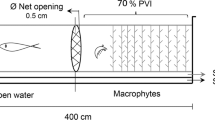Abstract
Predation by cyclopoid copepods is an important factor affecting zooplankton communities in freshwater habitats. Experiments provide strong evidence of the role of selective predation by cyclopoid copepods in structuring zooplankton communities. To assess the predation impact of a cyclopoid copepod, Mesocyclops pehpeiensis, we conducted a mesocosm experiment using 20-l polyethylene tanks in which the density of the predator and the food available to herbivorous zooplankton varied. M. pehpeiensis had a notable but selective effect on the zooplankton community. The population of a small cladoceran, Bosmina fatalis was affected negatively, but M. pehpeiensis did not have any apparent impact on the population dynamics of another Bosmina species, B. longirostris. On the other hand, the population of small rotifers responded positively to the presence of M. pehpeiensis, and their densities increased in mesocosms with a high density of M. pehpeiensis. It seems that suppression of B. fatalis by M. pehpeiensis predation indirectly affected rotifers by releasing them from competition with B. fatalis. The results suggest that copepod predation is a powerful factor regulating zooplankton communities directly and indirectly.



Similar content being viewed by others
References
Adrian R (1991) The feeding behaviour of Cyclops kolensis and C vicinus (Crustacea, Copepoda). Verh Int Ver Limnol 24:2852–2863
Blumenshine SC, Hambright KD (2003) Top-down control in pelagic systems: a role for invertebrate predation. Hydrobiologia 491:347–356
Brandl Z (1998a) Feeding strategies of planktonic cyclopoids in lacustrine ecosystems. J Mar Syst 15:87–95
Brandl Z (1998b) Life strategy and feeding relations of Cyclops vicinus in two reservoirs. Int Rev Hydrobiol 83:381–388
Chang KH, Hanazato T (2002) Morphological defense of Bosmina fatalis against invertebrate predators in Lake Suwa. Verh Int Ver Limnol 28:1279–1283
Chang KH, Hanazato T (2003a) Vulnerability of cladoceran species to predation by the copepod Mesocyclops leuckarti: laboratory observations on the behavioural interactions between predator and prey. Freshwater Biol 48:476–484
Chang KH, Hanazato T (2003b) Seasonal and reciprocal succession and cyclomorphosis of two Bosmina species (Cladocera, Crustacea) co-existing in a lake: their relationship with invertebrate predators. J Plankton Res 25:141–150
Conde-Porcuna JM, Declerck S (1998) Regulation of rotifer species by invertebrate predators in a hypertrophic lake: selective predation on egg-bearing females and induction of morphological defences. J Plankton Res 20:605–618
Gilbert JJ (1985) Competition between rotifers and Daphnia. Ecology 66:1943–1950
Gilbert JJ (1988) Suppression of rotifer populations by Daphnia: a review of the evidence, the mechanisms, and the effects on zooplankton community structure. Limnol Oceanogr 33:1286–1303
Gilbert JJ, Williamson CE (1978) Predator-prey behavior and its effect on rotifer survival in associations of Mesocyclops edax, Asplanchna girodi, Polyarthra vulgaris, and Keratella cochlearis. Oecologia 37:13–22
Gliwicz ZM, Lampert W (1993) Body-size related survival of cladocerans in a trophic gradient: an enclosure study. Arch Hydrobiol 129:1–23
Gliwicz ZM, Umana G (1994) Cladoceran body size and vulnerability to copepod predation. Limnol Oceanogr 39:419–424
Hanazato T, Yasuno M (1985) Population dynamics and production of cladoceran zooplankton in the highly eutrophic Lake Kasumigaura. Hydrobiologia 124:13–22
Hanazato T, Yasuno M (1987) Experimental studies on competition between Bosmina longirostris and Bosmina fatalis. Hydrobiologia 154:189–199
Hanazato T, Yasuno M (1991) Insights into competition in zooplankton communities derived from studies using experimental ponds. Verh Int Ver Limnol 24:1572–1580
Haney JF, Hall DJ (1973) Sugar-coated Daphnia: a preservation technique for Cladocera. Limnol Oceanogr 18:331–333
Hopp U, Maier G, Bleher R (1997) Reproduction and adult longevity of five species of planktonic cyclopoid copepods reared on different diets: a comparative study. Freshwater Biol 38:289–300
Kumar R, Rao TR (1999) Demographic responses of adult Mesocyclops thermocyclopoides (Copepoda, Cyclopoida) to different plant and animal diets. Freshwater Biol 42:487–501
Kumar R, Rao R (2003) Predation on mosquito larvae by Mesocyclops thermocyclopoides (Copepoda: Cyclopoida) in the presence of alternate prey. Int Rev Hydrobiol 88:570–581
Li JL, Li HW (1979) Species-specific factors affecting predator-prey interactions of the copepod Acanthocyclops vernalis with its natural prey. Limnol Oceanogr 24:613–626
Marker AFM, Nusch EA, Rai H, Riemann B (1980) The measurement of photosynthetic pigments in freshwaters and standardization of methods: conclusions and recommendations. Arch Hydrobiol Beih 14:91–106
Matsumura-Tundisi T, Rietzler AC, Espindola ELG, Tundisi JG, Rocha O (1990) Predation on Ceriodaphnia cornuta and Brachionus calyciflorus by two Mesocyclops species coexisting in Barra Bonita reservoir (SP, Brazil). Hydrobiologia 198:141–151
Plaβmänn T, Maier G, Stich HB (1997) Predation impact of Cyclops vicinus on the rotifer community in Lake Constance in spring. J Plankton Res 19:1069–1079
Rao TR, Kumar R (2002) Patterns of prey selectivity in the cyclopoid copepod Mesocyclops thermocyclopoides. Aquat Ecol 36:411–424
Roche K (1990) Some aspects of vulnerability to cyclopoid predation of zooplankton prey individuals. Hydrobiologia 198:153–162
Santer B (1993) Potential importance of algae in the diet of adult Cyclops vicinus. Freshwater Biol 30:269–278
Shao Z, Xie P, Zhuge Y (2001) Long-term changes of planktonic rotifers in a subtropical Chinese lake dominated by filter-feeding fishes. Freshwater Biol 46:973–986
Williamson CE (1986) The swimming and feeding behavior of Mesocyclops. Hydrobiologia 134:11–19
Acknowledgements
This study was partly supported by a Grant-in-Aid (no. 14580567) to T. Hanazato from the Japan Society for the Promotion of Science, and a Grant-in-Aid from the JSPS Fellowship Program to T. Hanazato and K. H. Chang (no. 03104).
Author information
Authors and Affiliations
Corresponding author
About this article
Cite this article
Chang, KH., Hanazato, T. Impact of selective predation by Mesocyclops pehpeiensis on a zooplankton community: experimental analysis using mesocosms. Ecol Res 20, 726–732 (2005). https://doi.org/10.1007/s11284-005-0089-y
Received:
Accepted:
Published:
Issue Date:
DOI: https://doi.org/10.1007/s11284-005-0089-y




